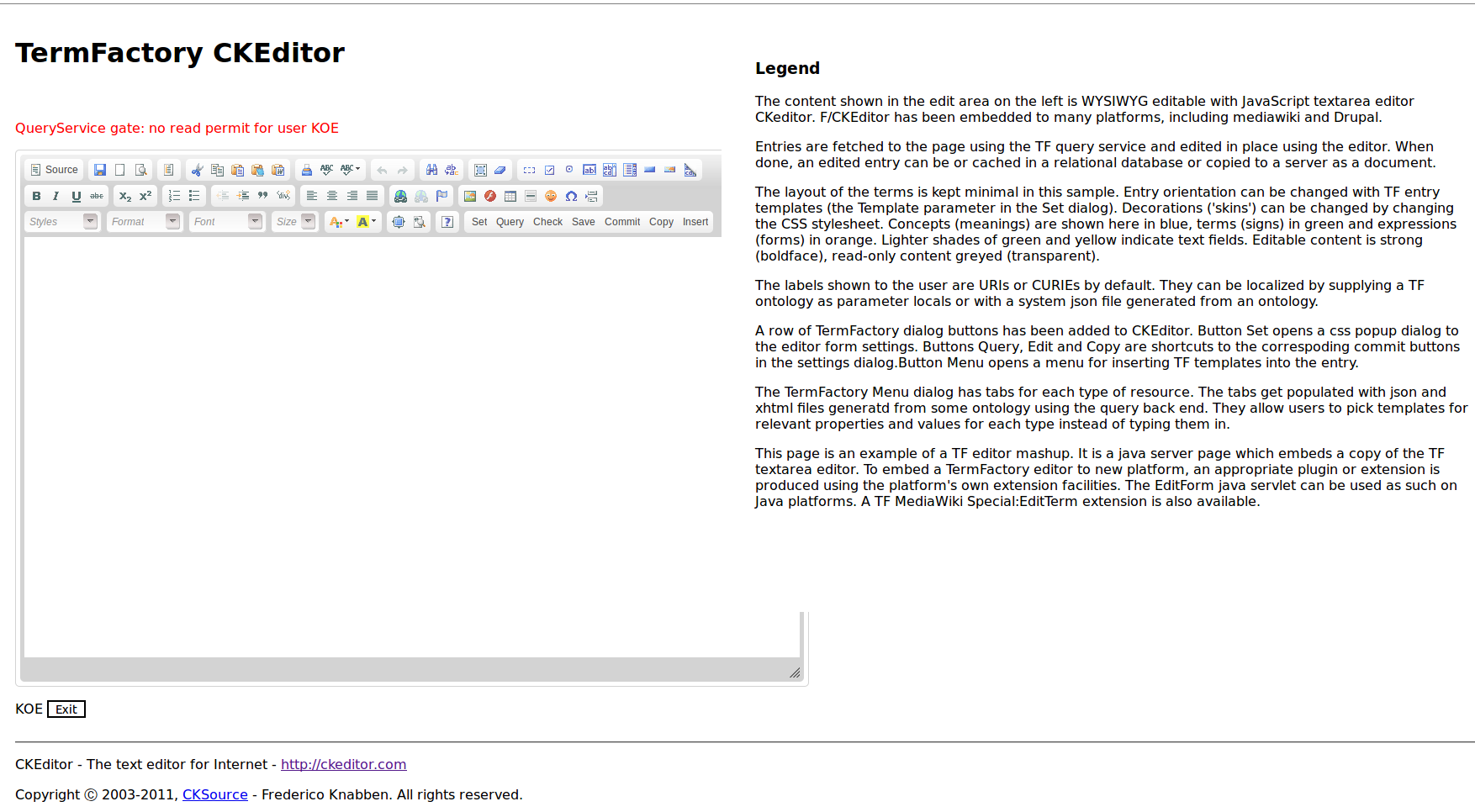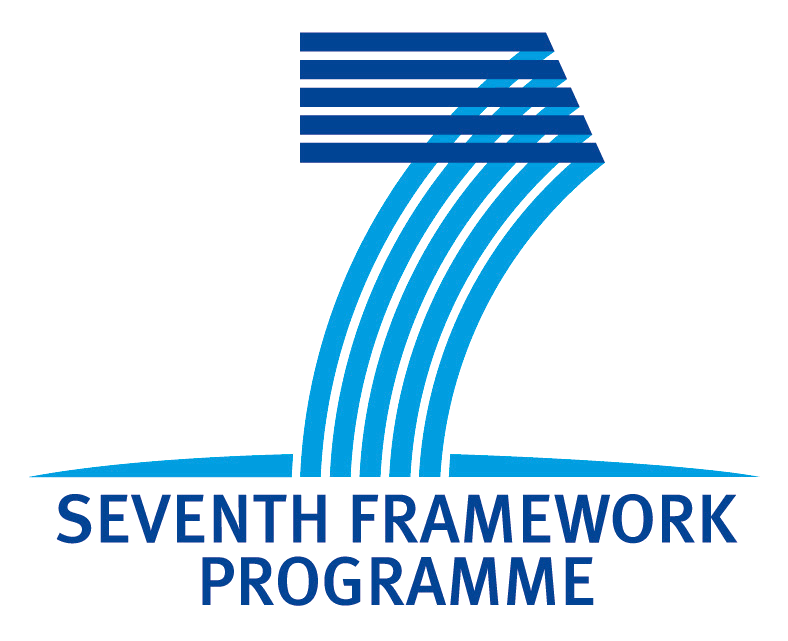3.2 The extended translation tools prototype
We now move on to the extended prototype. We first recapitulate how the extended translation tools extend the one-translation scenario to a community of translators collaboratively using and maintaining MOLTO translation tools.
3.2.1 User management
For more flexibility (as well as vendor independence), the open source LDAP (The Lightweight Directory Access Protocol) based user management implementation from GlobalSight has been adapted for MOLTO. It allows distinguishing different roles and user groups, and controlling access to resources by roles. The GlobalSight user management solution has been conservatively extended for the needs of MOLTO TermFactory users. The following screenshot displays a user's roles as an ontology editor.

Term ontology management roles are defined per domain, where a domain is represented by a regular expression on ontology URIs. The MOLTO GlobalSight user management system lets a company project administrator create users and grant them MOLTO TermFactory ontology read and write permissions. The TermFactory back end GateService reads the permissions off the GlobalSight LDAP directory and database and controls access to TermFactory content accordingly. If a user's credentials are not sufficient, TermFactory Gate will not permit term ontology queries or commits. The MOLTO permissions come over and above any constraints that ontology endpoints may impose on the content they manage. They enable fine grained project level control on who is allowed to do what to shared or restricted TermFactory resources.

3.2.2 Document management
The simple document manager of the prototype editor remains to be upgraded to a more sophisticated XLIFF based document manager built using the GlobalSight document management API. See the MOLTO TT API document for more detail.
3.2.3 Lexical resources
A key consideration for the usability of MOLTO translation is the ease with which its text coverage can be extended by a user community. We need to pay great attention to adaptability. The most important factor in extensibility is lexical coverage. Grammatical coverage can be developed and maintained with language engineering, and grammatical gaps can often be circumvented by paraphrasing. In contrast, paraphrasing is not a real option for special domain terms. There are two cases to consider: either the abstract grammar misses concepts, or concrete grammars for some language/s are missing equivalents. In the first case, we need to extend the domain ontology and its abstract grammar. In the second case, we need to add terms.
For both ontology and term management, we apport to MOLTO the TermFactory ontology based terminology management concept. TermFactory is a system of distributed multilingual term ontology repositories maintained by a network of collaborative management platforms. It has been described at length in the TermFactory Manual at http://www.helsinki.fi/~lcarlson/CF/TF/doc/TFManual_en.xhtml.
The user of the MOLTO translation editor has direct access through the equivalents editor to querying and editing term equivalents for concepts already in available ontologies, either already in TermFactory or 'raw' from the Web of Data, in particular, the OntoText services serving data from FactForge repository.
3.2.3.1 Term management
Say for instance there is no equivalent listed for cheese in some language's concrete grammar FooLang. The author/translator can use the equivalents editor to query for terms for the concept food:Cheese in TermFactory or do a search through OntoText services for candidate equivalents, or, if she knows the answer herself, submit equivalents through the equivalents editor. The new equivalent/s are saved in the user's own MOLTO lexicon, and submitted to TermFactory as term proposals for the community to evaluate.
3.2.3.2 Ontologies
If there is a conceptual gap not easily filled in through the equivalents editor, there is the option of forwarding the problem to an appropriate TermFactory collaborative platform. This route is slower, but the quality has a better guarantee in the longer run, as inconsistency or duplication of work may be avoided. Say there is no concept in the domain ontology for the new notion that occurs in the source text. In easy cases, new concepts can be added through the equivalents editor, subclassing some existing concept in the ontology. In more complex cases, where negotiations are needed in the community, an ontology extension proposal is submitted through a TermFactory wiki. TermFactory offers facilities for discussing and editing ontologies and their terms. In due time, them modified ontology gets implemented in a new release of the GF domain abstract grammar.
3.2.3.3 Ontology-grammar interface
TermFactory ontologies are extensible and support reasoning. Instead of implementing domain ontology-to-grammar bridges over and again for every new domain and application, it seems more promising to take advantage of the semantic network structure of (term) ontologies. Suppose verbalizations are already defined for a selection of upper or middle level ontologies. Special domain ontologies can subclass them and thereby also inherit the verbalizations that go with the superclasses and properties. UHEL is currently looking at the generalization of the MOLTO museum case ontology-to-grammar mapping in this direction.
3.2.4 Translation editing
The TT translation editor is just a prototype. Different scenarios and platforms may call for different combinations of its features. One way to go is to extend the prototype with further tabs and facilities for CAT tool support. But there is the also the opposite alternative to consider of calling MOLTO translation tool services from a third party editor. GlobalSight has two built in translation editors, called popup editor and inline editor. The popup editor is a Trados TagEditor lookalike, while the inline editor has something of the look and feel of old Trados versions running WYSIWYG on Microsoft Word. The inline editor has been implemented in javascript using the FCKEditor library. It might just be feasible to embed MOLTO prototype editor functionalities into the GlobalSight editor(s). In the Globalsight setup, there is already support for importing cut-and-dried MT translations from a MT service, but here we are talking about something rather more intricate.
It is not immediately obvious which route would provide least resistance. From the point of view of GF usability, finding a neat way of embedding GF editing functions in third party translation editors could be a better sales position than trying to maintain a whole new MOLTO translation environment. (Unless of course, the new environment is clearly more attractive to targeted users than existing ones.) We may also try to have it both ways.
3.2.5 Reviewing/feedback
It was noted above that blind translation in the case of incomplete or inadequate coverage in resource grammars can occasion a round of reviewing and giving feedback on the translations before publication. This part of the process is in its main outlines familiar from the translation industry workflow, and can be implemented as a variation of it. In the MOLTO workflow, reviewer comments are not returned (just) to the human author/translator(s), but they should have repercussions in the ontology and grammar management workflows. This part requires modifying and extending the existing GlobalSight revisioning tools to communicate with the MOLTO lexical resources and grammar services. The GlobalSight revisioning tools now use email as the human-to-human communication channel. We probably want to use a webservice channel for machine-to-machine communication, and possibly some web commenting system as an alternative to email.
3.2.6 Grammar engineering
To the extent grammar engineering can be delegated to translation tool users, it must happen transparently without requiring knowledge of GF. One way to do this is through what is known as example-based grammar writing in GF. Example-based grammar writing is a new GF technique for backward-engineering GF source from example translations. It can play a significant role in the translation-to-grammar feedback cycle. This part of the TT API will be borrowed from the MOLTO Grammar Developer Tools API.
The following sections describe what parts of the above list are already in place in the prototype and what remains to do.
- Printer-friendly version
- Login to post comments
- Slides
What links here
No backlinks found.


